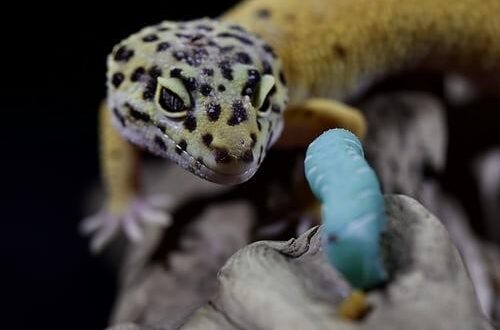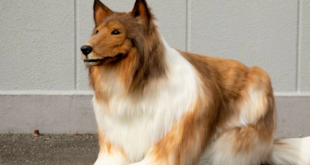Leopard geckos make fascinating pets due to their distinctive colors and amiable nature. These small reptiles are simple to get at pet stores and reptile exhibitions, and they thrive in medium-sized settings if their basic needs are met. One of the first questions many people have after getting their first leopard gecko is what to feed it. Whereas many reptiles eat a variety of foods, such as insects, fruits, and vegetables, the leopard gecko will only eat insects. Aside from providing suitable habitat for your gecko, you should also consider giving it a nutritious, well-balanced diet.
What Do Leopard Geckos Eat?
Leopard geckos are lizards that eat insects. They typically seek invertebrates in the wild. While their exact natural diet varies, they generally eat crickets, spiders, grasshoppers, hornworms, caterpillars, flies, beetles, and even small scorpions based on the biodiversity of their habitat.
Mealworms
The most common insect to feed your leopard gecko is mealworms. They’re easily available at most pet stores and are budget-friendly. They keep for a long time and can even be bred if you wish to feed your pet at a lesser cost. They’ll be a hit with your leopard gecko, and despite their relatively high-fat content and low calcium to phosphorus ratio, you shouldn’t have any trouble making them a regular part of your pet’s diet.
Mealworms have the downside of being slow-moving. They don’t provide much stimulation for the leopard gecko because catching them is just too easy. The hard outer shell can create stomach difficulties, and because they like to burrow, retrieving them at mealtime can be difficult.
Waxworms
Waxworms will be a favorite food of your leopard gecko, and it will go to considerable lengths to obtain them, even ignoring other foods in the process. Waxworms are nutritious, but they are high in fat and can cause your pet to gain weight. To avoid obesity and the health concerns that come with it, most experts advocate giving them as a special treat on occasion. Some owners use them as a reward to induce obstinate geckos to eat once again. While breeding waxworms is not difficult, it is usually best to buy a few at a time because they are not suitable for regular feeding.
Dubia Roaches
For your leopard gecko, you can get a variety of roaches, including the Turkestan cockroach, but the Dubia is the most preferred. You won’t have to worry about this roach escaping because it can’t climb. They don’t make a lot of noise and are rather easy to reproduce provided you can provide a warm, dark location. They have a great nutritional value, are easy to gather at feeding time, and excite the hunting instinct because they move more quickly than mealworms.
While Dubia roaches have several advantages, they are significantly more expensive than the other solutions we’ve explored. Because some people have trouble maintaining a good breeding habitat, you may need to purchase them frequently, and they are not as common as crickets or mealworms.
Crickets
Crickets are another excellent food for your leopard gecko, and many people prefer them because they are more nutritious. Crickets also jump, which stimulates your pet’s natural hunting instinct, making them feel comfortable while also increasing their activity levels, which can help them lose weight. It’s also low in fat, easily digestible, and high in protein for your pet. They’re similar to mealworms in that they’re quite easy to buy or raise, and if you have enough room, you can keep a low-cost food source running indefinitely.
Crickets stink, which you may not have known unless you’ve previously owned lizards. Keeping even a couple of them in a cage can leave a distinct odor in the room. The incessant hopping and chirping might be rather annoying, and they frequently manage to escape, especially when being collected for your leopard gecko.
Hornworms
Hornworms are a favorite delicacy for many leopard geckos. Protein, calcium, fiber, and phosphate are all abundant, but fat and chitin are scarce.
Feeders from Other Sources
Breeders can provide more appealing feeders, such as hornworms, silkworms, and various roaches. Because of their near-perfect calcium to phosphorus ratio, black soldier fly larvae are very appealing.
What Foods are Dangerous to Leopard Geckos?
Leopard geckos are poisoned by light-emitting insects like fireflies. These bugs contain compounds that are exceedingly harmful to geckos, so they should never be fed to them.
Additionally, leopard geckos can be poisoned by insects obtained in the wild. There is a risk in feeding the pet insects you have collected in the wild, and opinion is divided whether this is a safe practice or not.
If you want to feed the gecko insects you’ve collected yourself, please ensure you have a complete knowledge of which insects are poisonous to geckos and how to avoid pesticide contamination. So, try to stick to your own garden.
Supplements with Vitamins and Minerals
Unfortunately, no home diet can match the variety found in lizards’ natural habitats. That’s why you should dust feeder insects with specialized reptile nutritional supplements in the form of powder and gut-load them before offering them to your pet.
Leopard geckos have high calcium requirements that aren’t always covered by dusting alone—this is especially important for young and breeding females. As a result, you can place a tiny tray in the tank with pure calcium supplements. A calcium-deficient gecko will seek it out and lick it. To avoid overdosing, utilize ordinary calcium instead of vitamin D3-enriched calcium.
Gut-loading your feeders is another important approach to increase vitamin and mineral content in your gecko’s diet. Gut loading entails feeding premium, nutrient-dense food to the insects for 24-48 hours before delivering them to your pet. It’s important to note that loading does not cut out the use of supplements, and vice versa.
What Kind of Drink Should a Leopard Gecko Have?
Your Leopard Gecko must drink clean freshwater, which should always be available in its container. Make sure the container is shallow enough that your gecko can drink from it easily and won’t drown if it manages to climb into it. The dish should be stable to avoid spillage because the cage’s substrate should be maintained dry.
We hope you liked reading this advice and found it useful in deciding what to feed your pet.
 HammBurg Be informed with latest news, reviews, entertainment, lifestyle tips, and much more.
HammBurg Be informed with latest news, reviews, entertainment, lifestyle tips, and much more.




